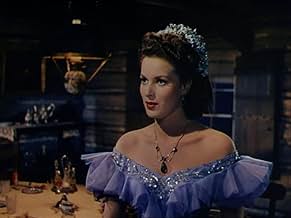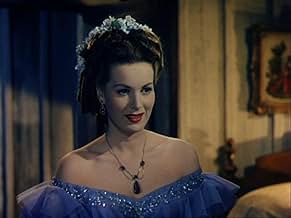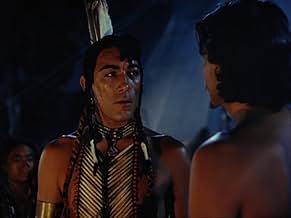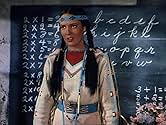Buffalo Bill
- 1944
- Tous publics
- 1h 30m
IMDb RATING
6.4/10
1.8K
YOUR RATING
The story of William "Buffalo Bill" Cody, legendary westerner, from his days as an army scout to his later activities as owner of a Wild West show.The story of William "Buffalo Bill" Cody, legendary westerner, from his days as an army scout to his later activities as owner of a Wild West show.The story of William "Buffalo Bill" Cody, legendary westerner, from his days as an army scout to his later activities as owner of a Wild West show.
- Awards
- 2 wins total
Carl Andre
- Trooper
- (uncredited)
Arthur Aylesworth
- Pool Player Debunking Cody
- (uncredited)
Evelyn Beresford
- Queen Victoria
- (uncredited)
Edward Biby
- Sergeant
- (uncredited)
Sidney Blackmer
- Theodore Roosevelt
- (uncredited)
Billy Bletcher
- Short Man
- (uncredited)
William A. Boardway
- Washington DC Cafe Customer
- (uncredited)
Featured reviews
If William F. Cody had lived until 1944 he would have loved this film. Most of all he would have approved of the casting of Hollywood's most straight arrow hero Joel McCrea as himself. That's the image Cody liked to convey even if it wasn't exactly the truth.
The real Cody was a brave enough hero all right and this film does mention some of the highlights of his real life, the buffalo hunt with Grand Duke Alexei of Russia, the hand to hand fight with Yellow Hand at War Bonnet Gorge, and the formation of his wild west show.
The trouble was the real Cody got into show business and he was ballyhooed out of all proportion to his real accomplishments. And Cody was lent himself admirably to exploitation.
The movie is the kind of ballyhoo that Cody would have approved. Cody's chief publicist in real life was Ned Buntline who is faithfully portrayed here by Thomas Mitchell. Maureen O'Hara is Louisa Frederici Cody and she's the faithful, but eastern bred wife. No hint of the real marriage problems that plagued the Codys.
Linda Darnell and Edgar Buchanan are in this film and I don't really know why. Darnell is an Indian school mistress and Buchanan is a grizzled old army trooper. No real reason for either of them in the film. Darnell is killed at War Bonnet Gorge and she must have been the first squaw who rode into battle. Buchanan's character is also left hanging in the air. Anthony Quinn is Cheyenne chief Yellow Hand and is Cody's worthy adversary on the screen.
Buffalo Bill Cody's real contribution was the wild west show. Cody had many imitators, but he was the original. Until Hollywood took over with the making of the first silent westerns, these shows created the myths surrounding the winning of the west. Sadly that part of Cody's life is given short shrift.
But Buffalo Bill would have loved this film. Whether today's audience would is open to speculation.
The real Cody was a brave enough hero all right and this film does mention some of the highlights of his real life, the buffalo hunt with Grand Duke Alexei of Russia, the hand to hand fight with Yellow Hand at War Bonnet Gorge, and the formation of his wild west show.
The trouble was the real Cody got into show business and he was ballyhooed out of all proportion to his real accomplishments. And Cody was lent himself admirably to exploitation.
The movie is the kind of ballyhoo that Cody would have approved. Cody's chief publicist in real life was Ned Buntline who is faithfully portrayed here by Thomas Mitchell. Maureen O'Hara is Louisa Frederici Cody and she's the faithful, but eastern bred wife. No hint of the real marriage problems that plagued the Codys.
Linda Darnell and Edgar Buchanan are in this film and I don't really know why. Darnell is an Indian school mistress and Buchanan is a grizzled old army trooper. No real reason for either of them in the film. Darnell is killed at War Bonnet Gorge and she must have been the first squaw who rode into battle. Buchanan's character is also left hanging in the air. Anthony Quinn is Cheyenne chief Yellow Hand and is Cody's worthy adversary on the screen.
Buffalo Bill Cody's real contribution was the wild west show. Cody had many imitators, but he was the original. Until Hollywood took over with the making of the first silent westerns, these shows created the myths surrounding the winning of the west. Sadly that part of Cody's life is given short shrift.
But Buffalo Bill would have loved this film. Whether today's audience would is open to speculation.
All the action in this movie is mostly towards the beginning-the indian vs calvary battle which bestows the famous reputation of indian-fighter on the main character, Buffalo Bill. The battle scenes are enhanced by the large numbers of real indians who were wearing real eagle feathers, and even the participation of a young indian woman in the battle(a similarity to the Custer battle, where indian women also participated). Staging a battle with large numbers of horses in the middle of a river must have been challenging. The indians would have probably chosen a much better site, but the storyline said they were in a hurry to get through a vital pass and so the clash.Buffalo Bill summarized his feelings for the indians by saying,"they were all my friends." the rest of the movie focuses on his personal life and tragedies. His final speech to his fans gave the viewer a feel for the about-to-be-lost glory and grandeur of the old west.It made me think of how far beyond anything C.B. DeMille ever did the true west really was.
"Buffalo Bill" is a highly romanticized picture of 'Buffalo' Bill Cody. While IMDb is correct that most of the things in this biopic are actually based on Cody's real-life exploits, most of the relationship between him and his wife was pure hooey. Sadly, there was no great love in Cody's life--or if there was, it wasn't his wife! Most of their life was spent apart by his choice--and there were other women in his life. But, this image of Bill would not have gotten past censors back in 1944, so the studio fictionalized this aspect of his life. The rest, however, is reasonably accurate--something that surprised me as I watched the film. He was a scout for the US Army in the west, he fought in the Indian wars and he did start up an incredibly successful Wild West Show.
Another aspect of the film that struck me was its treatment of the American Indians--particularly the Cheyenne. It was odd, as the major roles of the 'Indians' were played by Linda Darnell and Anthony Quinn!!! This insensitivity was pretty much the way American Indians were portrayed in American films through the 1950s. HOWEVER, despite this insensitivity, the film did correctly assert that the Indian wars were forced on these people due to how they were treated by the government. And, in this way, the film was much more balanced than many westerns of the day.
Overall, a somewhat inaccurate film that looked nice and featured the excellent acting, as usual, by Joel McCrea. Worth seeing--just not exactly the Gospel! And, the final line of the film might make you throw up--so when that little kid in the audience stands up, PLUG YOUR EARS!!!
By the way, the film made one HUGE mistake. General Sherman NEVER said "The only good Indian is a dead Indian". This quote was actually from General Sheridan--though it's not exactly what he said. When he was asked what a good Indian was like, he said very succinctly "...a dead one".
Another aspect of the film that struck me was its treatment of the American Indians--particularly the Cheyenne. It was odd, as the major roles of the 'Indians' were played by Linda Darnell and Anthony Quinn!!! This insensitivity was pretty much the way American Indians were portrayed in American films through the 1950s. HOWEVER, despite this insensitivity, the film did correctly assert that the Indian wars were forced on these people due to how they were treated by the government. And, in this way, the film was much more balanced than many westerns of the day.
Overall, a somewhat inaccurate film that looked nice and featured the excellent acting, as usual, by Joel McCrea. Worth seeing--just not exactly the Gospel! And, the final line of the film might make you throw up--so when that little kid in the audience stands up, PLUG YOUR EARS!!!
By the way, the film made one HUGE mistake. General Sherman NEVER said "The only good Indian is a dead Indian". This quote was actually from General Sheridan--though it's not exactly what he said. When he was asked what a good Indian was like, he said very succinctly "...a dead one".
I enjoyed watching the film "Buffalo Bill." Unfortunately close blood relations of Buffalo Bill were still living at that time, and they should have made an effort not to make errors.
Louisa Frederici met Cody in Saint Louis, and served out the end of the war there planning on making her his bride. They were married in her father's home (John Frederici) on South 8th Street in Saint Louis. They left right away for a steamboat to Kansas. Her father did not go along, and was NOT a Senator.
It is a fine film, and entertaining. When Bill Cody returned to the West in 1866 he was married! There was no Linda Darnell's character. Just once I would like for Hollywood to do an exact biography without changing the facts!
I am a Frederici descendant. Terry Alan Klasek Saint Louis, Missouri
Louisa Frederici met Cody in Saint Louis, and served out the end of the war there planning on making her his bride. They were married in her father's home (John Frederici) on South 8th Street in Saint Louis. They left right away for a steamboat to Kansas. Her father did not go along, and was NOT a Senator.
It is a fine film, and entertaining. When Bill Cody returned to the West in 1866 he was married! There was no Linda Darnell's character. Just once I would like for Hollywood to do an exact biography without changing the facts!
I am a Frederici descendant. Terry Alan Klasek Saint Louis, Missouri
A lavish Technicolor potboiler shot by Leon Shamroy, who later collected that year's Oscar for colour cinematography for 'Wilson'; although here the most spectacular scenes are obviously the work of Otto Brower's second unit, with the close ups of the leads shot back at the studio.
It commendably takes the side of the American Indian (represented here by Anthony Quinn and Linda Darnell, the latter wearing lots of makeup and the former very little of anything) against the vested financial interests back East, and also gives the plight of the buffalo a nod.
Maureen O'Hara thought her first western "would be forgettable, but it turned out to be one of the biggest moneymakers 20th Century-Fox had that year" and that Joel McCrea although "a very nice man, a good actor, but not rugged like Duke or Brian Keith". He's likeable, however and as usual gives the film heart.
It commendably takes the side of the American Indian (represented here by Anthony Quinn and Linda Darnell, the latter wearing lots of makeup and the former very little of anything) against the vested financial interests back East, and also gives the plight of the buffalo a nod.
Maureen O'Hara thought her first western "would be forgettable, but it turned out to be one of the biggest moneymakers 20th Century-Fox had that year" and that Joel McCrea although "a very nice man, a good actor, but not rugged like Duke or Brian Keith". He's likeable, however and as usual gives the film heart.
Did you know
- TriviaMuch of Cody's life as depicted in the film was true: He did fight to the death with Chief Yellow Hand and he did receive the Congressional Medal of Honor (although it was rescinded in 1917 because he was not in the army); his son, Kit Carson Cody, did die (but of scarlet fever, not diphtheria); his wife (not the daughter of a senator) had three other children.
- GoofsEarly in the film, Sergeant Chips McGraw refers to Buffalo Bill's "big Springfield" rifle but Bill is armed with an 1866 Winchester rifle in this scene.
- Quotes
William F. 'Buffalo Bill' Cody: What killed my son?
Doctor: Diptheria.
William F. 'Buffalo Bill' Cody: What's that?
Doctor: A germ.
William F. 'Buffalo Bill' Cody: Where does it come from?
Doctor: Water systems... and sewage. It's a crowd disease. A disease of civilization.
- ConnectionsEdited from Sur la piste des Mohawks (1939)
- How long is Buffalo Bill?Powered by Alexa
Details
- Release date
- Country of origin
- Language
- Also known as
- Buffalo Bill, der weiße Indianer
- Filming locations
- Production company
- See more company credits at IMDbPro
- Runtime1 hour 30 minutes
- Aspect ratio
- 1.37 : 1
Contribute to this page
Suggest an edit or add missing content





































